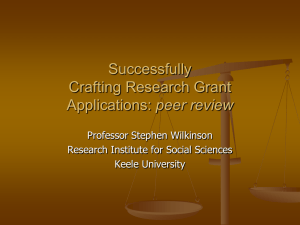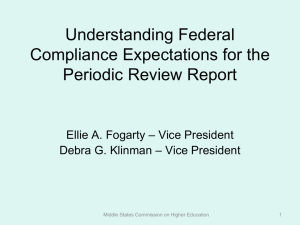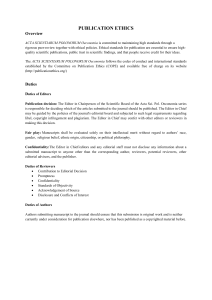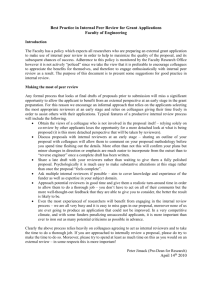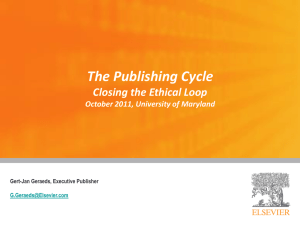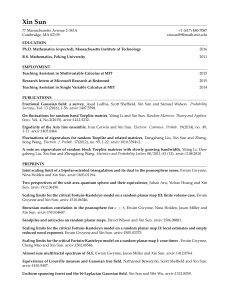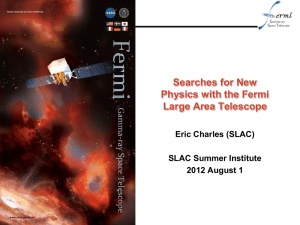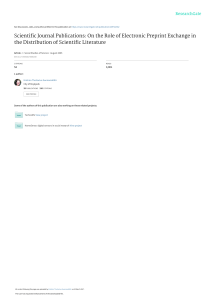CMPT 105 Building Interactive Systems
advertisement
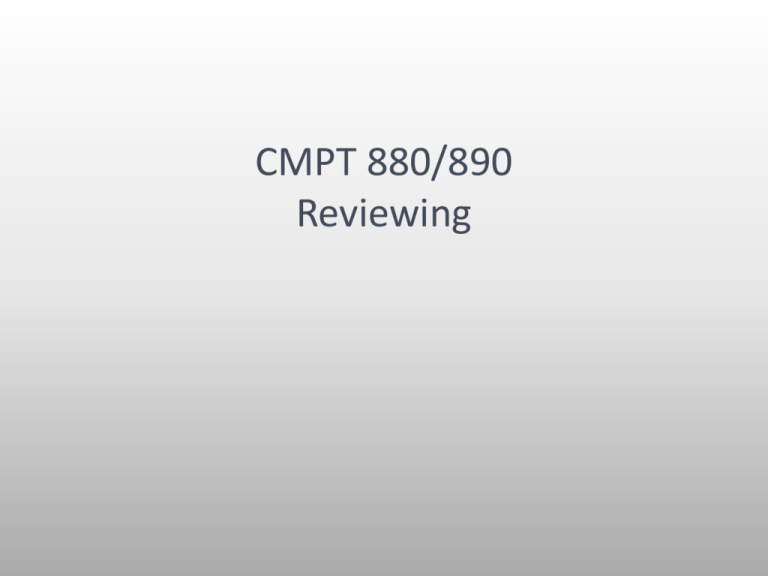
CMPT 880/890 Reviewing Outline What is peer review Why review? The review process Types of reviews How to review What is peer review? “a formal system whereby a piece of academic work is scrutinised by people who were not involved in its creation but are considered knowledgeable about the subject.” “also used to describe professional appraisal processes used to assess the performance of an individual, team, or department.” - Wager, Godlee, and Jefferson Types of reviews Degree of formality official review for a publication or agency informal review for a colleague Anonymity What are you reviewing? a paper a grant proposal a person (for hiring or promotion) For papers, type of publication conference paper, journal article, book chapter, book Why review? Peer review is a cornerstone of science Why do we need review at all? We (the research community) need to judge whether a proposed piece of work is in fact a contribution Why peer review? We are the experts who can best judge the contribution Why not judge everything for yourself? Not enough time Conferences and journals provide authority about what is worth reading Why review? When there are resources or prizes at stake, there is a need to decide on quality Limited number of spaces at a conference Limited number of pages in a journal Limited budget for a granting agency Limited number of Ph.D. dissertation scholarships Academic organizations are cheap! No money to pay expert reviewers All peer review is voluntary and unpaid Why review? Keep yourself up to date You get to look at the latest research (Can’t talk about it though) Build your career Reviewing is one of the checkmarks The review process CHI – a large conference on HCI The players: Two program co-chairs (“the chairs”) Associate chairs (“the ACs“) how many? number of submissions / 10 The secondary AC for a paper (“the 2AC”) The submitted papers (“the papers”) The authors of the papers (“the authors”) The peers who review the papers (“the reviewers”) The review process The timeline: September 20: paper submission deadline September 25: papers assigned to ACs by chairs September 30: papers assigned to reviewers by ACs October 30: review deadline (for reviewers) November 5: meta-review deadline (for ACs) November 10: reviews released to authors for rebuttal November 15: rebuttal deadline (for authors) November 15-25: discussion period (reviewers and AC) November 25: assignment of 2AC December 5: program committee (PC) meeting December 12: decisions sent to authors How are reviewers chosen? Depends on the publication In most cases, the AC tries to find the most expert reviewers for the paper involves reading the paper carefully who does the paper cite? learn a bit about the area, and who the experts are write to people and ask In some cases, automatic assignment from a DB Rules for reviewing anything Read the instructions to find out what you are being asked to do and why If you receive no instructions and are not clear about what you are being invited to do, ask for more information or decline the request Review the work not the person (unless you have been asked to do this), and don’t try to be clever Admit your limitations Be as objective as possible and take account of (and declare) any conflicts of interests. How to review 1. Get the invitation 2. Determine whether you can do the review 3. Read the paper for a general overview 4. Read the publication’s review criteria 5. Read the paper again, asking yourself questions see next slides 6. Decide on your score for the paper 7. Write your review, arguing for or against the paper 8. Decide on your expertise 9. Submit your review How to review Three questions to ask of every research report: Do I understand it? Are the question and the methods clearly explained? Do I believe it? Are the conclusions justified by the data and are the methods valid? Do I care? Is the question important and interesting? How to review What is the research problem or question? Is the problem/question well motivated? Is the solution/answer appropriate to the question? Is the evaluation appropriate? Are the conclusions valid? Is the work new compared to previous work? Is the work exciting and interesting? Is the work well presented? Does the paper adequately refer to previous work? Should the research be published in this venue? How to review Often specific questions will be given to you in the review form e.g., domain-specific questions Depends on the venue How to review Structure of your review report (often specified by the publication) 1. Summary of review and decision main reasons for decision 2. Summary of paper and main contribution what is the author claiming? 3. The review discussion of earlier questions 4. Summary Online review systems Tour of PCS How to get invited? Add your name to the review database for your conferences Ask your advisor to practice on their reviewing duties When not to review? In some cases you should not accept the request 1. You have a conflict of interest 2. You are not enough of an expert What is enough? 3. You will not be able to complete the review properly in the required time If you are going to refuse, best to do so right away arXiv - a peer review counterexample arXiv.org is an archive of preprints in physics and math more than 500,000 articles not peer reviewed how do they maintain quality? self-governance moderators ‘endorsements’ arXiv - a counterexample “The lack of peer-review, while a concern to some, is not considered a hindrance to those who use the arXiv. Many authors exercise care in what they post. A majority of the e-prints are also submitted to journals for publication, but some work, including some very influential papers, remain purely as e-prints and are never published in a peer-reviewed journal. A well-known example is a potential proof of the Poincaré conjecture uploaded by Grigori Perelman in November 2002. Perelman appears content to forgo the traditional peer-reviewed journal process, stating "If anybody is interested in my way of solving the problem, it's all there [on the arXiv] - let them go and read about it.“ While the arXiv does contain some dubious e-prints, such as those claiming to refute famous theorems or proving famous conjectures such as Fermat's last theorem using only high school mathematics, they are "surprisingly rare”. The arXiv generally re-classifies these works, e.g. in "General mathematics", rather than deleting them. Prominent parapsychologists - for example, Nobel laureate Brian Josephson, have complained that this reclassification amounts to academic censorship, and that the arXiv ought to have no bar to entry.” - Wikipedia


